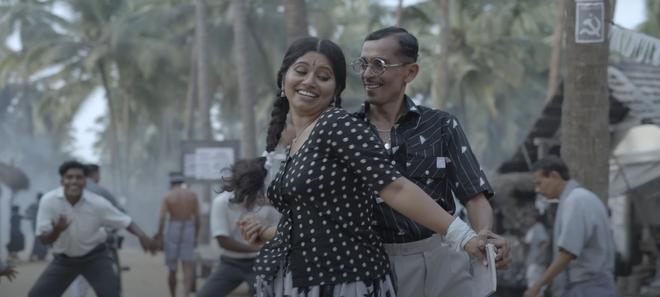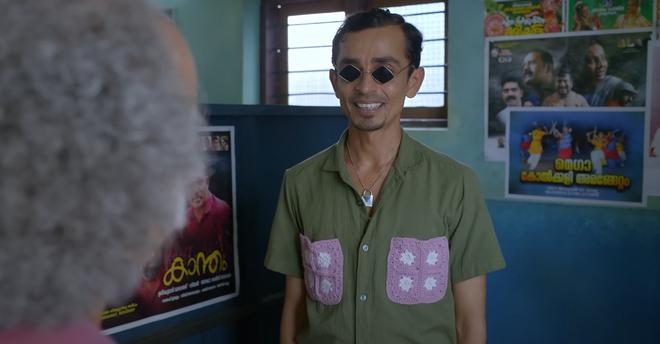Suresh and Sumalatha are back. After romancing viewers with their courtship in Ratheesh Balakrishnan Poduval’s blockbuster Nna Thaan Case Kodu, the lovebirds are back with their own story in Sureshinteyum Sumalathayudeyum Hridayahariyaya Pranayakatha (SSHP, The Heartwarming Love Story of Suresh and Sumalatha). Actors Rajesh Madhavan and Chithra S Nair reprise the characters they essayed endearingly in Nna Thaan….
Excerpts from an interview with the director and scenarist who made his debut in 2019 with Android Kunjappan Version 5.25.
The story of Suresh and Sumalatha are spinoffs from the blockbuster Nna Thaan…
The characters deserved a story. They were inspired by two people I know. In Nna Thaan…, they appear as witnesses but I felt they had an interesting back story that would be ideal for a film. Since Suresh and Sumalatha were welcomed by viewers, Rajesh and I felt their story would click as a movie.
And the long title…
This is a movie about two popular characters from a previous film. I wanted viewers to get a gist of the story from the title itself. It is a heartwarming story about the romance of Suresh and Sumalatha and that is exactly what the title says. Moroever, we have spent quite a bit on the film (laughs). Hence, we thought we would go with a long title. Quite some time, since we have had such a long one for a film!
The characters have the feel of caricatures. Was that the creativity of an art director-turned-director’s idea?
It was done deliberately. Even the world they inhabit is quirky, with all the quirkiness we see in the characters. The narrative also has the feel of a comic strip.
How far has your work as an art director influenced your movies?
A lot. Many of the ideas I could not explore while working as an art director are being experimented with in the movies I direct. That aspect is an inherent part of my storytelling. During shooting, I enjoy the beauty and perfection of that work.
Is there an incident you could share where your work as an art director seeps into your work as a director?
For instance, in this movie, the climax scene required drama. I wanted a palace. Our art director is Mumbai-based KK Muraleedharan. While the final set was being done, I was travelling abroad with my family. I was making sand castles with my kid, when I called Murali ettan. I told him we needed a palace made of mud. And that is how it has been designed. That is also how closely life and art is intertwined with my cinema.
Where was this shot?
It has shot in the border areas of Kasaragod and Kannur, places such as Cheemeni, Kanhangad, Cheruvathur…
Both Nna Thaan... and SSHP have characters speaking the Kasaragod dialect. Over the last few years, we have seen many movies that highlight the dialect…

Each dialect has its charm. This diversity of dialects was not much heard in earlier movies. There might have been an apprehension that it may not be easily comprehensible. Now, people travel and work in different places. The dialects of Kannur and Kasaragod have become mainstream. There is no need to change that into the Malayalam that is spoken formally. It is fine to retain the dialect and usage as they are. In fact, the audience enjoys it.
You had introduced several new actors in Nna Thaan…who became extremely popular. Has this been carried forward in this movie as well?
But for five actors (Rajesh, Chitra, Sudheesh, Jinu Jose and Sharanya), the rest are from theatre. Many of them are debutants in cinema and even as actors. They play significant roles. About 20 to 25 actors are new to cinema.
How did you select them?
Unlike the usual practice in cinema, we first did the casting for this film. The script was then a basic outline. Based on that, we selected the actors who would be ideal for certain characters. Then we fleshed out the script by incorporating the stories and experiences of the actors. Sometimes, it was after getting to know their behaviour and traits that we added their characters to the script. The characters they enact have a strong resemblance to who they are in real life. Theatre as an art form, and not the story as such, is a strong presence in this film. To show the evolution of theatre in Kerala, its state today and the lives of the actors, we have borrowed from the real-life stories of the actors in our cast.
How difficult was this process? The development of the script seems to have been an organic process….
Before we began the shooting, the script was ready. Scouting for locations, casting and writing the script went hand in hand. We had a complete storyline before we began location hunting and casting. But the journey of the characters was shaped by several factors. While finalising the script, we went back and made changes to it, decided the scenes that could be shot at a place, changed the set to suit the location… We decided how the casting should suit the locale and the scene. We thought through all this before we began shooting the movie. Of all the films I have directed, working on this was the most interesting. It was not easy but I found the challenges interesting.
Your style of working is to draw and make sketches that show the scenes, position of actors, placements of frames, props etc…
It is through sketches that I communicate with my crew to avoid any miscommunication. I depend on sketches to show how I visualise a set, to explain a frame to the director of photography, and to explain an edit pattern to the editor. I find that easier and there is no room for any doubts. I show the subjects in the foreground and background, what to include (even props) in a frame, the perspective of the actors in the scene and so on. It makes the work of the DOP easier.
By intertwining Suresh’s and Suma’s story with the iconic song ‘Aayiram kaanumaayi’ from yesteryear hit Nokkethadhoorathu Kannum Nattu, the characters’ romance was imbued with a touch of nostalgia. How inspired are you by old classics and film songs?
Music is the best way to elevate the mood of a scene in certain situations. Only dialogues may not work all the time. Usually, a background score is used. Instead of a new composition, an old track could be used. It has been extensively used in international cinema and in India too. I wanted a song that would gel with the scenes in my cinema. That is how I chose ‘Aayiram kaanamaayi...’. There is something special about the song, it’s a song that can go well with a wide range of emotions. It becomes apparent when you sync it with different scenes. There is romance, pangs of separation, and affection… the tune and the lyrics lend themselves to different situations. That was a kind of learning, how a song can enhance different moods. In Nna Thaan..., it has been used in a humorous way; in this film, it is used in romantic scenes.
This is a movie that does not feature any big names in cinema…

That’s a risk. But I feel viewers will appreciate good humour. Moreover, the characters essayed by Rajesh and Chithra have already found a place in the hearts of viewers. There was no question of replacing them since the film is about them.
Do other characters from Nna Thaan... find a place in this film?
Chackochan (Kunchacko Boban) makes a guest appearance.







